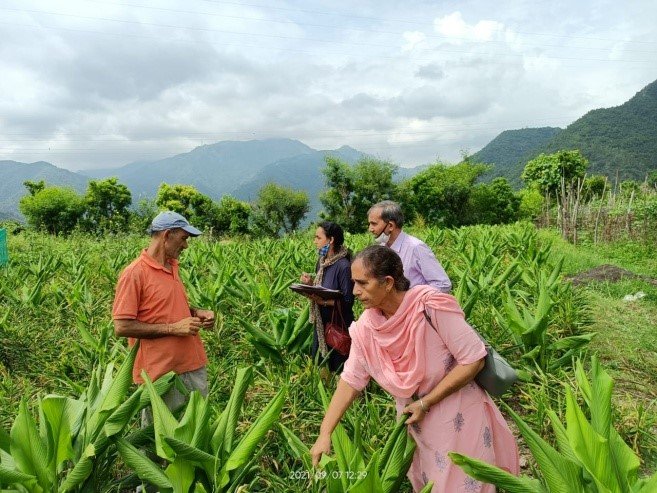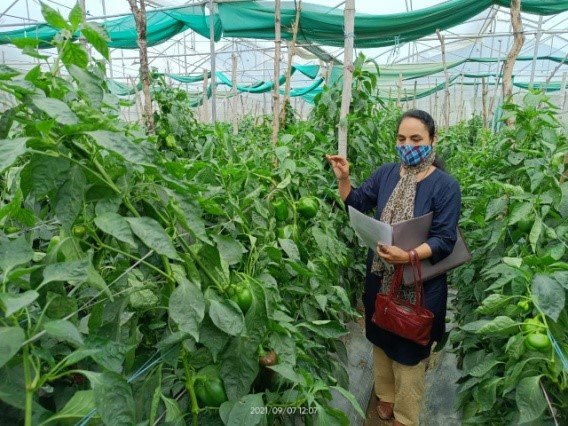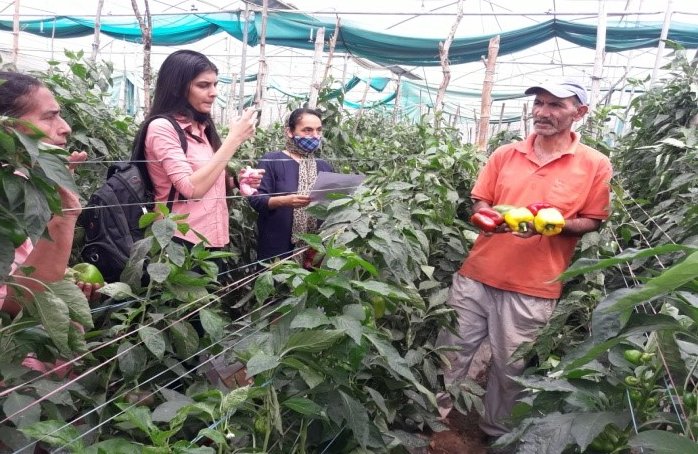Survey of Agribusiness Farm

Survey of Agribusiness Farm
On 7th September, 2021, Dr. SK Chauhan Dean of the college along with Mrs S. K Dhaliwal, Dr. Shanta Kumari and one post graduate student of Agricultural Economics (Ms. Pragati Sharma BS20MSAGE001) revisited agribusiness unit of Sh. Nagendra Thakur of Chaloga Vyas, Gram Panchayat, Kathli Bharan about 12 km from the Eternal University HQ, at Baru Sahib. Sh. Nagender Thakur a progressive and innovative farmer was contacted and interviewed for various business plans implemented on his farm. The village is having kuchha road constructed under Pradhan Mantri Gram Sadak Yojana. The village is located about 1200 mt above mean sea level. The PG student of Department of Agricultural Economics was trained in conducting interview of the farmer, identification of cash crops, first hand information for analyzing vermi- compost farming, protected cultivation under poly house, conservation and utilization of rain harvesting water, dairy farming, etc.
During survey, it was found that some of the local practices to cope with climate change (experiencing 50% less rainfall with reduced frequency of rains) are environmentally sustainable like collection of roof and rain water in cemented tanks and wells for irrigation through drip and sprinklers in raising cash crops like multi coloured sweet pepper, celery, snow peas, broccoli, ice berg, lettuce, Chinese cabbage, cauliflower, cherry tomatoes, different varieties of brinjal, ginger, garlic, peas and some fruits like mango, avocado. Besides, mixed farming through proper rotation, mulching, vermicompost, well planned production schedule matched with market demand of crop products with dairying has been proved to be one of the most important farming systems to combat the effect of climate change. The salient features of progressive farmer have been described as under:
(A) Personal information & demographic profile
| 1 | Identification of progressive farmer | Sh. Nagendra Thakur, (M): 8265077007 Village Chaloga Vyas of Kathli Bharan Panchayat, District Sirmour H.P |
| 2 | Age and social status | 53 Years and ward member of Panchayat |
| 3 | Qualification acquired | MA (Political Science), B. Ed. & certificate course in disaster management |
| 4 | Type of family and structure | Nucleus of seven members (Mother, wife, 1 son and 3 daughters) |
(B) Resource Inventory
| 1 | Size of land holding | 100 bigha (8 ha), Cultivated land 16 bigha (1.28 ha). |
| 2 | Poly house | 2 of 500 m2 each |
| 3 | Investment on water storage infrastructure (wells and tanks) to combat the effect of climate change (reduced rainfall) | Rs 13 lakh (Water storage capacity of 15 lakh litre in tanks & wells of different sizes). Manage rain & roof harvesting water and lift water from a stream 3km distance. Recently got constructed another community rain water harvesting tank with capacity of 1.50 lakh litre under MGNREGA to irrigate land on down side. |
| 4 | Livestock | Four Jersey and Sahiwal milking cows, one heifer, one calf and a murrah buffalo |
| 5 | Milk production | 20 litre/day |
(C ) Motivation and training for adoption of cash crops and sustainable farming
| 1 | Source of inspiration for the adoption of cash crops | Rural Centre for Human Interest (RUCHI), NGO |
| 2 | Formal training before starting commercial vegetable farming | Acquired one week trainings each from SAUs like CSK HPKV, Palampur &YSP UHF, Solan |
| 3 | Year of starting vegetable farming on commercial scale | 2013-14 |
(D) Cropping pattern for enhanced income and market outreach
| 1 | Crops grown before 2013-14 | Ginger in 1.5 bigha with production of 4 qt and green peas in 2 bigha getting production of 5 qt and maize, wheat in rest of the land. Follow rotation to maintain fertility & mulching to conserve moisture |
| 2 | Major crops grown now in open and protected environment of two poly houses | Seven colour sweet pepper, celery and snow peas, Broccoli, ice berg, lettuce, Chinese cabbage, cauliflower, cherry tomatoes, tomato with pole beans, different varieties of brinjal, ginger, turmeric, garlic, peas, blue berry |
| 3 | Traditional crops raised | Maize almost zero but wheat in 2-3 bigha |
| 4 | Major markets exploited | Delhi, Chandigarh and hotels at Ludhiana |
| 5 | Mode of marketing | Directly to hotels and to wholesalers |
| 6 | Fruit and medicinal plants raised | Avocado, mango, hard, bhera, amla, |
(E) Season wise gross household income and employment generation
| 1 | Major crop production seasons | Rainy(June- Oct) & Winter season (March-April) |
| 2 | Income earned in rainy season Income earned in winter season | Rs 8.50 lakh, Rs 3.50 lakh |
| 3 | Price fetched for exotic vegetables | Yellow capsicum (pepper) (Rs 100-200/kg), snow peas (Rs 50-60/kg), lettuce (Rs 50-60/kg) and broccoli (Rs 100-150/kg) |
| 4 | Prize winning | Two prizes won at district level |
| 5 | Labour utilization | Two permanents labour @ Rs 6000/month with free lodging. Three four casual labourers per day @ Rs 300/day for 3-4 months in peak season |
| 6 | No. of persons trained/guided to adopt vegetable farming | One hundred who were mostly illiterate |
(F) Capital formation and future plans
| 1 | Capital formation through income generated from mixed farming | Made investment on agriculture machinery, tools and implements such as two power tillers, bush cutter, spray pumps, power chaff cutter and cemented water tanks. Has purchased one ha land at Rajgarh for developing horticulture |
| 2 | Future plans | Growing new exotic vegetables which are in demand from hotels. To grow nursery of apple, persimmon, plum, pomegranate from local rootstock. |
| 3 | Message for others | Job seekers rural youth to adopt sustainable farming for self-employment and to become job givers |


